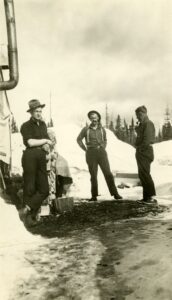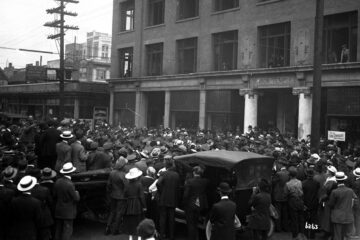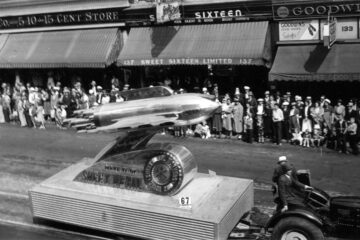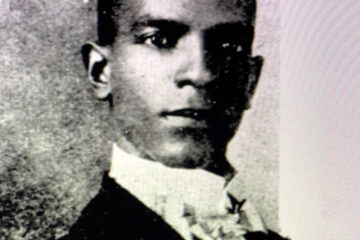Raising the Scarlet Banner High
The 1930s in Prince George, B.C.
by Donna Sacuta and Dr. George Davison
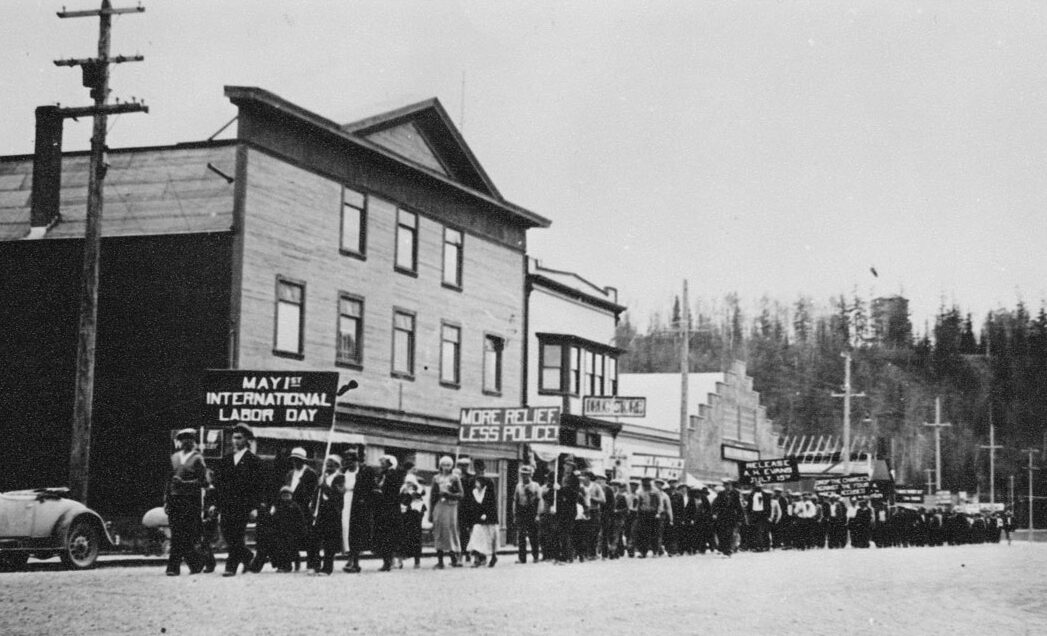
“A parade of protestors on George Street, Prince George, B.C. on International Labour Day, May 1st, 1933.” Fraser Fort George Regional Museum, P985.17.1.
In November 1932, the foreman at the Penny B.C. relief camp, 100 kms east of the city, struck one of the residents in the back of the head with the flat side of a double-bladed axe during a heated argument.
Penny was a “non-work” camp designed to hold unemployed men who had been causing trouble in the city. The camp accomodated over 100 men. An epidemic of dysentery and flu had broken out before the axe attack, and a delegation of the men demanded the camp foreman ask for medicine. The foreman refused, and that’s when the attack took place. The foreman left soon after, and the next day the police and a new foreman arrived. The new foreman also came down with dysentery. Two men were taken to hospital in Prince George and a doctor was sent to treat the sick.
The Depression Years in Prince George, B.C.
With a population of 2,479 in 1931, the city of Prince George had hundreds of unemployed. Relief payments were funded first by municipal governments, then provincial and federal dollars would top it up. The system broke down when municipalities could not afford relief payments on top of their other expenses.
By early 1931 a branch of the communist-led National Unemployed Workers Association (NUWA) was established in the Prince George District. Under the watchful eye of the police, the men held meetings, picnics and staged demonstrations to protest inadequate government response to the grim conditions.
Obeying the “laws of the stomach”
In April 1932, the workers at several highway construction projects east of Prince George went on strike, demanding an increase in pay. The strike was settled, but they were soon on strike again when the promises dried up. In July 1932 the camps were shut and the men returned to Prince George, where they took their demands to government representatives first, and then to the streets.
175 men marched on a local grocery store and asked for food. They told the owner to send the bill to the provincial government. Store owner C.C. Reid, negotiated with the men and donated $15 worth of food to them. When the police admonished the men, the leaders of the NUWA replied that they advised the men to obey the laws of the stomach. (Hak, 50)
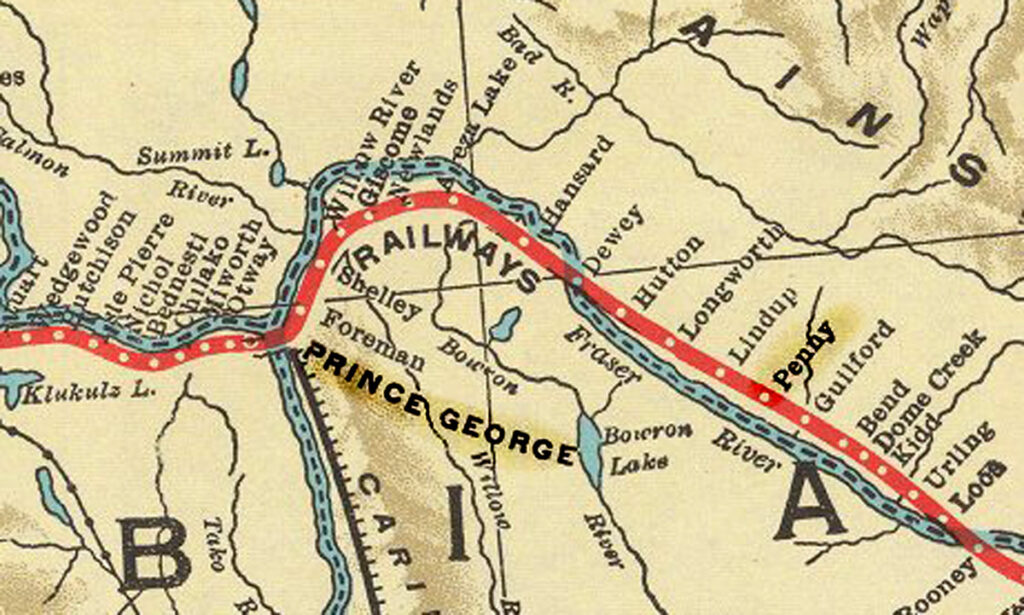
Map showing communities east of Prince George. A relief camp was established at Penny, B.C., as a means of controlling unrest in the city. Canadian National Railway. (1927). Alaska and the Yukon — Routes of Canadian National Pacific Coast Services, Canadian National Steamship Company Ltd. David Rumsey Map Collection.
The NUWA continued to organize and demonstrate through the fall, and fought off all charges brought against them. With winter approaching and no relief payments coming, officials discussed deporting some of the men. Instead they were relocated to “non-work” camps east of the City. The camps proved to be fertile ground for “revolutionary challenge to the established order”. (Hak, 48)
After the dysentery outbreak at Penny, the camp foreman complained to the local MLA the men at Penny were singing the “Red Flag” at camp committee meetings. In January 1933, four of the Penny men were deported.
Comrade Steve Berlinic Dies
On February 27, 1933, Steve Berlinic, who had participated in the 1932 summer demonstrations in Prince George, died. A large funeral procession was held for him and on May 1, 1933 (International Labor Day) a parade of 150 made their way to an outdoor meeting at Duchess Park. Banners included “More Relief Less Police”, “Workers of the World Unite” and “Release A.H. Evans July 15th”. The last is a reference to communist organizer Arthur “Slim” Evans, jailed for union activities in Princeton in 1932.
A three-and half-foot (one metre) high concrete headstone was erected at Berlinic’s grave in the Prince George cemetery two days after the parade. Not much is known about Berlinic, but his headstone remains at the cemetery as a testament to the failures during the economic crisis of the 1930s. The final two lines have been obliterated by time.
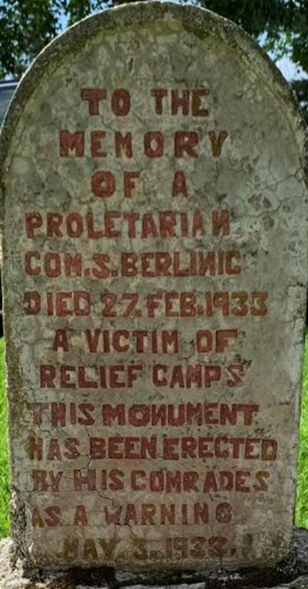
A three-and half-foot (one metre) high concrete headstone was erected at Steve Berlinic’s grave in the Prince George cemetery, where it remains today.
TO THE MEMORY OF A PROLETARIAN
COMRADE S. BERLINIC
DIED FEB. 27, 1933
A VICTIM OF RELIEF CAMPS
THIS MONUMENT HAS BEEN ERECTED BY HIS COMRADES
AS A WARNING
MAY 3, 1933
ONE FOR ALL
ALL FOR ONE
Throughout 1934 and 1935 various organizations in Prince George continued to organize workers. There were several skirmishes with the police and City Council. By then, the Department of National Defence had set up its “20 Cents A Day” work camps across the country, but none were in the Prince George District.
Many of the fit Penny camp men were sent to Spence’s Bridge. One of the men, Benjamin Gillespie, did not report for work, and his body was found several months later, apparently another victim of relief camps, this time by suicide.
The repression that followed saw several strikers sentenced to long jail terms.
At the next census in 1941, Prince George’s population had fallen to 2,047.
Source: Hak, G. “The Communists and the Unemployed in the Prince George District, 1930-1935.” BC Studies: The British Columbian Quarterly 68 (1985): 45–61.
